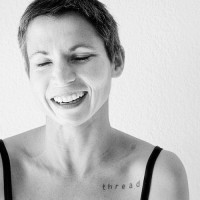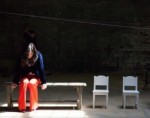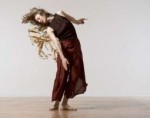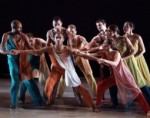Partial Glossary: Material Construction at the Kelly Writer’s House
by Kirsten Kaschock
Bios — short for “biographies.” The artists below appear in the order in which they presented. Their numbers will be used as short-hand in the glossary entries, to cite the presentations in which each concept was discussed.
(1) Bonnie Jones: Korean-American writer, improvising musician, and performer working primarily with electronic music and text. She presented a live digital experiment, projecting words as she typed them and, simultaneously, creating an electronic soundscape.
(2) Meg Foley: dance artist and director of Moving Parts, uses movement to ask existential questions about the human experience of being both alone and with others. Foley discussed her process, then improvised in voice and body as she navigated a packed room of 35 audience members, inviting them to respond as they wished.
(3) Laura Neuman: poet/performing artist who has recently worked with Philadelphia dance artists, taking the language they use with one another to fuel her poetry. Neuman asked volunteers to perform an exercise on diminishing gesture that she learned at the Workshop for Potential Movement before reading an excerpt from her poetry.
(4,5) Megan Bridge: dancer and dance-maker who currently co-directs Fidget Space, a platform for her collaborative work with Peter Price. Price creates digital sonic and visual environments for live performance, while Bridge grounds her dances in the discourses of contemporary art, culture, and theory. Bridge and Price discussed the Brian Massumi text behind “Mauri & Lorin: a performance-lecture on the synchronization of affect,” a work first performed at the Fringe. They then showed the audience a video excerpt of the piece and asked volunteers to read Massumi’s theoretical text while embodying ideas such as “imprecise,” or “hardened.”
Cursor, flashing — first image of the evening, projected on a screen in the front of the room. The blinking line suggested writer’s block/writer’s work as it stuttered, then raced down the page. The writer’s body remained at the back of the room, behind a desk piled with electronic equipment. (1)
Discussion 50%-Doing 50% — percentage of language-to-movement in the Foley studio. She calls the unspeakable moment of transition from one to the other “the chasm between.” (2)
Explore my fertile country — a movement exercise. (2) An example of “beautiful conceptual language” used by dancers in the development of work. (3)
Fallible language — language that can fail. In dance studios she visited while researching, Neuman learned that “beautiful conceptual language does not equal beautiful movement sequences: it is not a one-to-one ratio.” (3)
Gesture — a piece of movement that “feels nameable even if it’s not.” (2) Also, a unit of investigation, e.g., how small can a performer make a gesture and still have it be “read” by an audience? (3)
Handmade sweater — illustration of human activity camouflaged by its resulting product: how a sweater may be said to carry more value than the invisible labor involved in its production. Similarly, a body typing projected text (even if the body is visible) is made secondary by the foregrounding of media-product. (1) Text can be invisible as well: dance-artists rarely offer the audience the source texts they use during the development process. When they do, a slew of issues about textual delivery arises, dance suddenly crossing into theater. (4,5) See also: ghost in the machine.
Intent, choreographic — Bridge’s desire, for instance, that a dense theoretical text read aloud during performance be experienced as “texture,” that it still provide “glimpses of meaning,” and that it accomplish both of these without alienating the audience. (4)
Kindergartner (you-look-like-a) — how a dancer moving through a minefield of academic-types was told she appeared. “You’re not the first person I’ve heard that from.” (2)
Lecture-performance — oxymoron? Usually, but not this time.
Mauri & Lorin... — a desk, a chalkboard, and two performers in their skivvies. And if its development process were titled? “How To Let Go of Meaning Long Enough to Read Philosophy With a Mouthful of Triskets.” (4,5)
Neurons, mirror — a biological explanation both for empathy (3) and for the irresistible urge to move when confronted by a dancer three feet away. (2)
Poem — gesture captured in language? As in the excerpt Neuman read from her poem “Insects (Objects) Photography is Not How I Love You.” (3)
Query — the audience asks: “Can the body lie?” The speaking-dancer answers: “Everything I say is vaguely true/everything I say is true.” (2)
Slippery — how dance may feel to an audience member asked to describe it. How concepts behind art-making feel to a writer asked to sum-up four diverse and heady artist-talks. (1,2,3,4,5)
Voice — a catch-all term to refer to a unique identity in speech, on the written page, choreographically, artistically. Intersecting voices can create cacophony. Or meaningful conversation. Or both. (1,2,3,4,5)
Word — see gesture. A unit of text that can be investigated in writing, as in Jones’s technological improv “P is for Pattern.” (1) Or, by meditating on its meaning in the body, as in “Mauri & Lorin...” (4,5) Or, in its endless redefinition depending on context, as in a glossary.
Yes — a straightforward answer to the ridiculous (yet persistently asked) question: “Do performers have anything valuable to say about performance?” (1,2,3,4,5)
Zero dollars — the cost of attending an artist talk or poetry reading. The value: beautiful confusion, thought fragments ricocheting around the head like popcorn, a feeling of connectivity to creative work and the persons behind it—the ghosts who articulate the machine.
Material Construction
Kelly Writer’s House
December, 7, 2011 at 7pm
One night only
Editor Note: Three of the performers mentioned--Megan Bridge, Meg Foley and Peter Price--are participants in the thINKingDANCE project.
By Kirsten Kaschock
December 19, 2011









